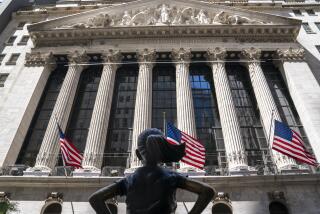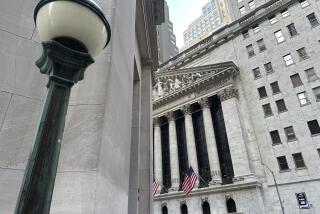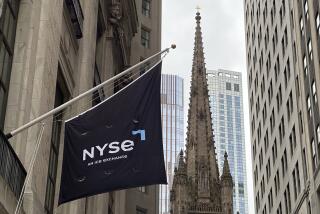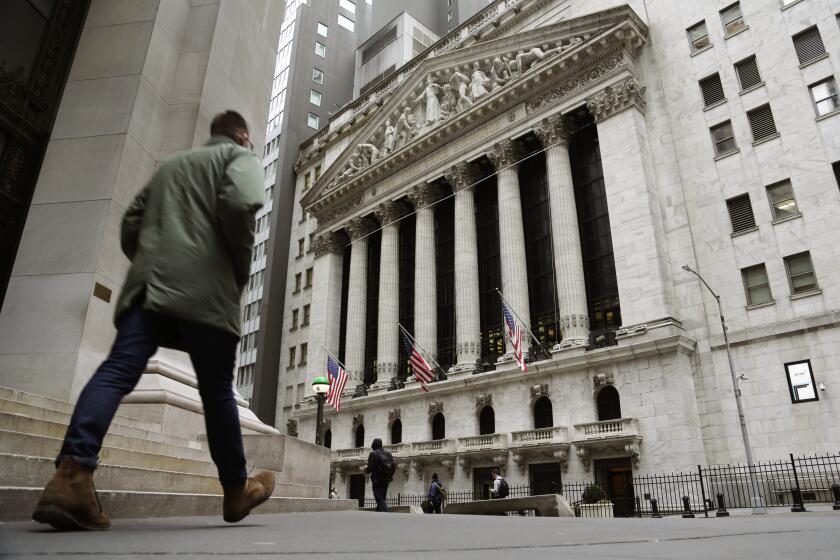Treasury Bond Yield Nears 8% in Broad Selloff : Wall Street: Reports of surging economy send inflation fears up sharply. Some analysts now see Fed rate hike as early as Friday.
- Share via
Long-term Treasury bond yields jumped Wednesday to just under 8%--their highest level since May, 1992--raising grave new worries about the economy’s strength and what the Federal Reserve Board might do about it.
In the latest sign that the economy remains on a roll, the government said Wednesday that factory orders rose in August at the fastest pace since 1992.
The news spurred yet another selloff in the bombed-out bond market, as traders immediately assumed that growth is strong enough either to fuel inflation or spur the Fed to tighten credit again--or both.
The bellwether 30-year Treasury bond yield leaped from 7.88% on Tuesday to a high of 7.97% during Wednesday’s trading, before closing at 7.94%, a 28-month high.
Many analysts now believe the Treasury bond yield is certain to top 8% soon, a level last seen on May 5, 1992. The 8% wall could be breached Friday if the government’s report on September employment shows faster-than-expected job growth.
Rumors were rife in the bond market Wednesday that the employment report will be robust enough to force another Fed interest rate hike, possibly Friday.
Eight months after the Fed began raising rates to brake consumer and business spending, “there is no assurance that the economy has lost any steam,” said Louis Crandall, economist at bond research firm R.H. Wrightson in New York. “The question now is, what does it take to slow this economy down?”
After the Fed’s fifth credit-tightening move, on Aug. 16, bond yields stabilized temporarily as Wall Street assumed that short-term rates had risen enough to guarantee a waning economy.
But since mid-September, economic data has increasingly suggested that growth remains healthy and that prices of raw materials are rising at a pace that could eventually translate into higher consumer inflation.
Those concerns have sparked renewed dumping of bonds by loss-ridden investors who fear that interest rates, already up more than two percentage points across the board from a year ago, are destined to go much higher.
Individual investors may just have been getting more comfortable with the bond market, until the latest selloff began two weeks ago. In a report issued Wednesday, mutual fund tracker Lipper Analytical Services noted that most bond fund categories eked out positive “total returns” in the third quarter, as interest earnings marginally offset the continuing decline in principal values.
But for the year to date, investors in long-term U.S. government bond mutual funds have lost 9% of their principal, on average, as rising market rates have devalued older bonds. Even after counting interest earned, investors in long-term U.S. government bond funds are out 4.8% of their investment since Jan. 1, on average.
Ian MacKinnon, fixed-income chief at fund giant Vanguard Group in Valley Forge, Pa., concedes that he and many of his peers on Wall Street were convinced that interest rates were near their top in August, when the 30-year T-bond yield was at 7.5%. “Now we don’t know where the end is,” he said. “There’s no sign of a slowdown in the economy.”
But many experts believe the bond market’s biggest problem is simply that impatient traders have panicked. Historically, there has been a six- to 12-month lag between the first Fed credit-tightening moves and bona fide signs of slower growth.
“Any time that interest rates have risen by as much as they have risen during 1994, growth slowed significantly in the following year,” said Donald Straszheim, economist at Merrill Lynch.
Indeed, despite the continuing carnage in the bond market as yields surge again, many bond pros believe a T-bond yield near 8%--which translates into corporate bonds near 9%--is a terrific return that will eventually attract a horde of new bond buyers.
But Jack Utter, manager of the IDS Strategy Income bond fund in Minneapolis, acknowledges that most potential bond investors are still frozen in place as yields continue to rocket. “People are thinking about buying, but they’re not acting yet,” he said.
Bonds: Rising Rates, Deepening Losses
The continuing surge in market interest rates this year has caused deep principal losses for bond fund owners. Here are average principal losses and total returns (principal loss adjusted for interest earnings) for key bond fund categories, Jan. 1 through Sept. 30. Also shown is the 30-year Treasury bond yield’s monthly closes (except latest).
Category Avg. principal loss Total return Short-term U.S. govt. -4.9% -1.5% GNMA -7.5% -2.8% General muni -8.7% -4.9% Long-term U.S. govt. -9.0% -4.8%
30-year Treasury bond yield Wednesday: 7.94%
Source: Lipper Analytical Services
How Bond Funds Fared
Here are average total returns for key categories of bond mutual funds for three periods ended Sept. 30, as reported Wednesday by Lipper Analytical. Total return includes interest earnings plus or minus any change in the bonds’ principal value.
Average total return Fund category 3rd qtr. 9 mos. 1 yr. Global bonds, long-term +2.01% -5.6% -2.7% Money market +0.98 +2.5 +3.1 High-quality corporate bonds, 1- to 5-year +0.90 -0.3 +0.3 Global money market +0.90 -1.9 -0.5 U.S. govt. bonds, 1- to 5-year +0.67 -1.5 -1.2 Lower-quality corporate bonds, long-term +0.65 -4.5 -4.3 GNMA bonds +0.55 -2.8 -2.5 High-quality corporate bonds, 5- to 10-year +0.53 -3.4 -3.5 Mixed bonds +0.48 -4.7 -2.7 Calif. muni bonds, long-term +0.48 -5.1 -4.2 U.S. govt. bonds, 5- to 10-year +0.38 -3.6 -3.8 General muni bonds, long-term +0.37 -4.9 -3.9 High-quality corporate bonds, long-term +0.25 -4.8 -5.2 Adjustable-rate mortgage bonds +0.08 -0.5 -0.1 U.S. govt. bonds, long-term +0.03 -4.8 -5.3 Junk corporate bonds -0.10 -2.5 +2.1
Source: Lipper Analytical Services Inc.
More to Read
Inside the business of entertainment
The Wide Shot brings you news, analysis and insights on everything from streaming wars to production — and what it all means for the future.
You may occasionally receive promotional content from the Los Angeles Times.










